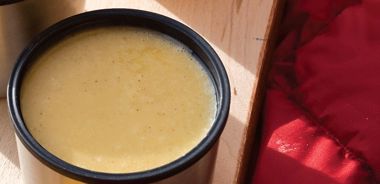Squash and Banana Soup

Each spoonful of this sumptuous soup will warm your bones. Add a pinch of cayenne if you like it hot.
1 ripe banana, unpeeled
1 butternut squash, peeled, cut in cubes (about 4 to 5 cups or 1 to 1.25 L)
1/4 cup (60 mL) butter
2 Tbsp (30 mL) each brown sugar and honey
1 medium onion, chopped
2 garlic cloves, chopped
1 tsp (5 mL) curry powder
1/2 tsp (2 mL) cinnamon
1/4 tsp (1 mL) nutmeg
1 cup (250 mL) coconut milk
3 cups (750 mL) vegetable broth or water
Juice of 1 lime
1/4 tsp (1 mL) each salt and pepper or to taste
Preheat oven to 350 F (180 C).
Line baking sheet with foil or parchment paper. Place unpeeled banana on one end of baking sheet and place squash on rest of sheet. Cut 2 Tbsp (30 mL) of butter into tiny bits. Sprinkle on squash, along with brown sugar and honey. Cook for 20 minutes; remove banana and set aside. Stir squash and roast 10 minutes longer.
Melt remaining butter in large pan on medium heat. Add onion and cook, stirring frequently for 5 minutes or until translucent. Add garlic, curry powder, cinnamon, and nutmeg. Cook for 1 minute, stirring frequently.
Peel banana and add it and any juices to pan. Add squash, coconut milk, and 2 cups (500 mL) of stock. Bring to boil on high heat. Reduce heat, cover and simmer for 10 minutes.
Purée in batches in blender until smooth. Stir in remaining stock until soup reaches desired consistency; add lime juice, salt, and pepper. Store in a spill-proof insulated container.
Makes 4 servings.
Each serving contains: 376 calories; 3 g protein; 24 g total fat (15 g sat. fat, 0 g trans fat); 44 g carbohydrates; 4 g fibre; 430 mg sodium
source: "Cross-country Skiing Banquet", alive #327, January 2010





